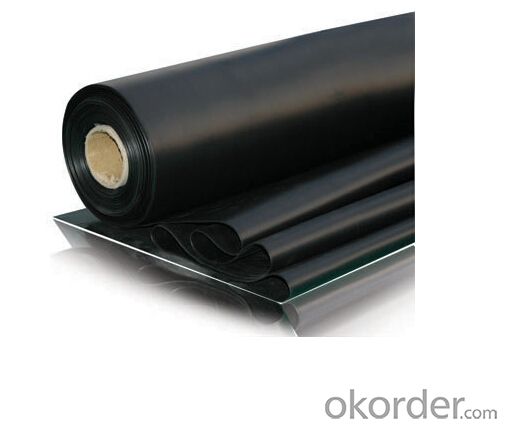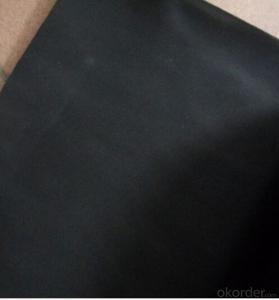EPDM Rubber Waterproof Membrane Used for Roof and Under Basement
- Loading Port:
- Qingdao
- Payment Terms:
- TT or LC
- Min Order Qty:
- 2000 m²
- Supply Capability:
- 200000 m²/month
OKorder Service Pledge
OKorder Financial Service
You Might Also Like
1. Product Feature for EPDM Waterproof Membrane:
a. UV resistant and anti-corrosion
b. High tensile strength and good elongation.
c. Easy installation, solid joint, and no environmental pollution
d. Good rooting penetration resistance
e. Service life up to 50 years
2. Product Specification for EPDM Waterproof Membrane:
There are two installation ways.one is full sticking,the other is hot welding.
Thick | 1.0mm,1.2mm,1.5mm,2.0mm,3.0mm or others |
Width | 1m to 4m |
Length | 20m |
Model | EPDM, EPDM with fabric |
3. Product Application:
1. Roofs, Basement, Toilet
2. Industrial and civil building waterproofing
3. Geosynthetic liner for swimming pool, channels, irrigation system
4. Especially suit for projects with high requirements in durability, anti-corrosion and deformation.
4. Some photos:


RFQ:
1) What's your package?
one roll with one woven bag, then 15-20rolls in one pallet
2) What's your payment terms?
T/T or L/C at sight
3) What's your delivery time?
Within one week against advance payment received
- Q:Can a waterproofing membrane be used for a restaurant?
- Yes, a waterproofing membrane can be used for a restaurant. A waterproofing membrane is a protective layer that is applied to surfaces to prevent water penetration. In a restaurant setting, where there is a significant amount of water usage in areas such as kitchens, dishwashing areas, and bathrooms, a waterproofing membrane can be beneficial in preventing water damage and moisture-related issues. It can be applied to walls, floors, and ceilings to create a barrier against water, ensuring the longevity and durability of the restaurant's infrastructure. Additionally, a waterproofing membrane can help maintain a clean and hygienic environment by preventing the growth of mold and mildew, which can be harmful to both the structure and the health of the occupants.
- Q:Can a waterproofing membrane be applied in cold weather conditions?
- Yes, a waterproofing membrane can be applied in cold weather conditions. However, it is important to follow the manufacturer's guidelines and use specific cold-weather adhesive or primer to ensure proper adhesion and effectiveness of the membrane.
- Q:Can a waterproofing membrane be used in boat decks or marinas?
- Yes, a waterproofing membrane can be used in boat decks or marinas. Boat decks and marinas are constantly exposed to water, making them prone to damage and deterioration over time. A waterproofing membrane can provide an effective solution to protect these surfaces from water intrusion, preventing issues such as rotting, warping, and mold growth. The membrane acts as a barrier, preventing water from seeping into the underlying structure and causing damage. It also helps to maintain the structural integrity of the boat deck or marina, prolonging its lifespan. Additionally, a waterproofing membrane can enhance the safety of these surfaces by reducing the risk of slip and fall accidents, as it can provide a slip-resistant surface. Overall, using a waterproofing membrane in boat decks or marinas is a wise choice to ensure their durability, longevity, and safety.
- Q:Can waterproofing membranes be applied over existing surfaces?
- Yes, waterproofing membranes can be applied over existing surfaces. These membranes are designed to adhere to a variety of materials such as concrete, wood, metal, and more. However, it is important to ensure that the existing surface is clean, free of any loose materials or contaminants, and properly prepared before applying the waterproofing membrane for optimal results.
- Q:How does a waterproofing membrane handle water pressure from adjacent structures?
- A waterproofing membrane is designed to handle water pressure from adjacent structures by acting as a barrier that prevents water from seeping through. It resists the force exerted by the water pressure and ensures that no water can penetrate into the protected area.
- Q:Can a waterproofing membrane be used on both horizontal and vertical surfaces?
- Yes, a waterproofing membrane can be used on both horizontal and vertical surfaces. Waterproofing membranes are designed to create a barrier against water penetration, regardless of the surface orientation.
- Q:What is rigid waterproof, flexible waterproof?
- 4, rigid waterproof and rigid waterproof material is not the same concept, the same flexible waterproof and flexible waterproof material is not the same concept. Such as polyethylene polypropylene is a flexible waterproofing membrane, with polymer mortar (or bonded paste) bonded polyethylene polypropylene composite waterproof layer, it is rigid waterproof, because the mortar binder in the grassroots deformation will crack , The web between the web and the web can not withstand the deformation of the grassroots, and the water infiltrates from the lap to cause damage to the waterproofing layer.
- Q:Can a waterproofing membrane be used on retaining walls?
- Yes, a waterproofing membrane can be used on retaining walls. Retaining walls are often exposed to moisture and hydrostatic pressure, which can lead to water infiltration and deterioration of the structure. Applying a waterproofing membrane on the retaining wall can help prevent water penetration, protect the wall from moisture-related damage, and prolong its lifespan. The membrane acts as a barrier, preventing water from seeping into the wall and causing potential issues such as efflorescence, cracks, or erosion. It is important to choose a waterproofing membrane that is specifically designed for below-grade applications and is capable of withstanding the pressure exerted by the retained soil. Additionally, proper installation techniques and appropriate drainage systems should be considered to ensure the effectiveness of the waterproofing membrane on retaining walls.
- Q:Can a waterproofing membrane be used for seawalls or bulkheads?
- Seawalls or bulkheads can benefit from the use of a waterproofing membrane. These membranes are specifically designed to create a barrier against water, and they can be applied to various structures, including seawalls and bulkheads. The materials used for these membranes, such as bitumen, rubber, PVC, or polyurethane, are known for their excellent resistance to water and their ability to maintain the integrity of the wall or bulkhead. By applying the membrane to the surface of the structure, a continuous and durable waterproof layer is formed, effectively preventing water from seeping through. This protective layer helps safeguard the seawall or bulkhead from erosion, corrosion, and other types of damage caused by exposure to seawater. Moreover, waterproofing membranes offer additional advantages, including increased durability, improved aesthetics, and enhanced resistance to UV rays and chemicals. In conclusion, the use of a waterproofing membrane is a reliable solution for ensuring the long-term performance and durability of seawalls and bulkheads in marine environments.
- Q:Are waterproofing membranes suitable for stadium structures?
- Waterproofing membranes are well-suited for stadium structures. Stadiums are exposed to different weather conditions, such as rain, snow, and humidity, which can potentially harm the structure if proper waterproofing measures are not taken. By providing a protective layer that prevents water infiltration, waterproofing membranes safeguard the stadium from moisture-related problems like leaks, mold, and corrosion. Water accumulation on large roof areas and expansive seating areas is common in stadium structures, making waterproofing essential. Membranes can be applied on various surfaces, such as concrete, metal, and wood, offering a versatile and effective waterproofing solution for stadiums. Furthermore, waterproofing membranes offer durability and longevity, which is crucial for stadiums that experience heavy usage and constant exposure to the elements. They are designed to withstand thermal expansion and contraction, as well as UV radiation, ensuring long-term protection for the structure. Moreover, architects and engineers can customize waterproofing membranes to meet specific design requirements, seamlessly integrating them into the stadium's overall aesthetic. These membranes come in various colors, textures, and finishes, allowing them to blend with the surrounding materials and enhance the stadium's visual appeal. In conclusion, waterproofing membranes are a reliable and effective solution for protecting stadium structures from water damage. They provide durability, versatility, and customization options, making them suitable for any stadium construction or renovation project.
1. Manufacturer Overview |
|
|---|---|
| Location | |
| Year Established | |
| Annual Output Value | |
| Main Markets | |
| Company Certifications | |
2. Manufacturer Certificates |
|
|---|---|
| a) Certification Name | |
| Range | |
| Reference | |
| Validity Period | |
3. Manufacturer Capability |
|
|---|---|
| a)Trade Capacity | |
| Nearest Port | |
| Export Percentage | |
| No.of Employees in Trade Department | |
| Language Spoken: | |
| b)Factory Information | |
| Factory Size: | |
| No. of Production Lines | |
| Contract Manufacturing | |
| Product Price Range | |
Send your message to us
EPDM Rubber Waterproof Membrane Used for Roof and Under Basement
- Loading Port:
- Qingdao
- Payment Terms:
- TT or LC
- Min Order Qty:
- 2000 m²
- Supply Capability:
- 200000 m²/month
OKorder Service Pledge
OKorder Financial Service
Similar products
New products
Hot products
Hot Searches
Related keywords





























